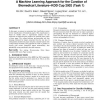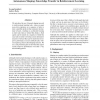995 search results - page 9 / 199 » Learning for Sequence Extraction Tasks |
SIGKDD
2002
13 years 7 months ago
2002
In this paper, we present an automated text classification system for the classification of biomedical papers. This classification is based on whether there is experimental eviden...
EMNLP
2008
13 years 9 months ago
2008
We consider a parsed text corpus as an instance of a labelled directed graph, where nodes represent words and weighted directed edges represent the syntactic relations between the...
ICML
2006
IEEE
14 years 8 months ago
2006
IEEE
Many real-world sequence learning tasks require the prediction of sequences of labels from noisy, unsegmented input data. In speech recognition, for example, an acoustic signal is...
ICML
2006
IEEE
14 years 8 months ago
2006
IEEE
We introduce the use of learned shaping rewards in reinforcement learning tasks, where an agent uses prior experience on a sequence of tasks to learn a portable predictor that est...
BMCBI
2010
13 years 7 months ago
2010
Background: Primer and probe sequences are the main components of nucleic acid-based detection systems. Biologists use primers and probes for different tasks, some related to the ...


